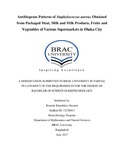| dc.contributor.advisor | Islam, Zubaida Marufee | |
| dc.contributor.author | Hussain, Benazir Khandaker | |
| dc.date.accessioned | 2018-01-21T04:38:50Z | |
| dc.date.available | 2018-01-21T04:38:50Z | |
| dc.date.copyright | 2017 | |
| dc.date.issued | 2017-06 | |
| dc.identifier.other | ID 13236013 | |
| dc.identifier.uri | http://hdl.handle.net/10361/9108 | |
| dc.description | This thesis report is submitted in partial fulfillment of the requirement for the degree of Bachelor of Science in Biotechnology, 2017. | en_US |
| dc.description | Cataloged from PDF version of thesis report. | |
| dc.description | Includes bibliographical references (page 54-57). | |
| dc.description.abstract | Staphylococcus aureus is the third most common food borne pathogen in the world. It is highly virulent and produces 20 different types of enterotoxins and it is recently being noticed that Staphylococcus aureus isolated from food is also developing antibiotic resistance. The purpose of this study was to isolate and identify Staphylococcus aureus from frequently bought food items from supermarkets around Dhaka. The samples are divided into three categories of food: milk and their products, packaged meat, fruits and vegetables. Thirty samples of these food groups were collected from three different supermarkets, most popular ones, around Dhaka and transported to the lab in sterile conditions. The extract was collect and organism isolated using selective medium Mannitol Salt Agar, MSA (HiMedia). The suspected colonies (16 isolates) were subjected to several biochemical tests to verify its identity. Positive samples were then subjected to an antibiotic sensitivity test. Following antibiotics were used: Nalidixic acid(30μg), Rifampicin(5μg), Tetracycline(30μg), Gentamicin(10μg), Amoxycillin(10μg), Co-trimoxazole(25μg), Novobiocin(30μg), Levofloxacin(5μg), Chloramphenicol(30μg), Oxacillin(1μg), Erythromycin(1μg), Ampicillin(10μg). More than half the samples isolated contained Staphylococcus aureus and some contained Staphylococcus epidermidis suggesting a public health concern due to contamination of food products by pathogenic bacteria. This contamination is a result of unhygienic processing, handling and storage in supermarkets. | en_US |
| dc.description.statementofresponsibility | Benazir Khandaker Hussain | |
| dc.description.statementofresponsibility | BRAC University thesis are protected by copyright. They may be viewed from this source for any purpose, but reproduction or distribution in any format is prohibited without written permission. | |
| dc.format | 61 pages | |
| dc.language.iso | en | en_US |
| dc.publisher | BRAC University | en_US |
| dc.rights | BRAC University thesis are protected by copyright. They may be viewed from this source for any purpose, but reproduction or distribution in any format is prohibited without written permission. | |
| dc.subject | Staphylococcus aureus | en_US |
| dc.subject | Antibiogram | en_US |
| dc.subject | Meat | en_US |
| dc.subject | Meat | en_US |
| dc.subject | Fruits | en_US |
| dc.subject | Vegetables | en_US |
| dc.subject | Supermarket | en_US |
| dc.subject | Food poisoning | en_US |
| dc.title | Antibiogram patterns of staphylococcus aureus obtained from packaged meat, milk and milk products, fruits and vegetables of various supermarkets in Dhaka city | en_US |
| dc.type | Thesis | en_US |
| dc.contributor.department | Department of Mathematics and Natural Sciences, BRAC University | |
| dc.description.degree | B. Biotechnology | |

